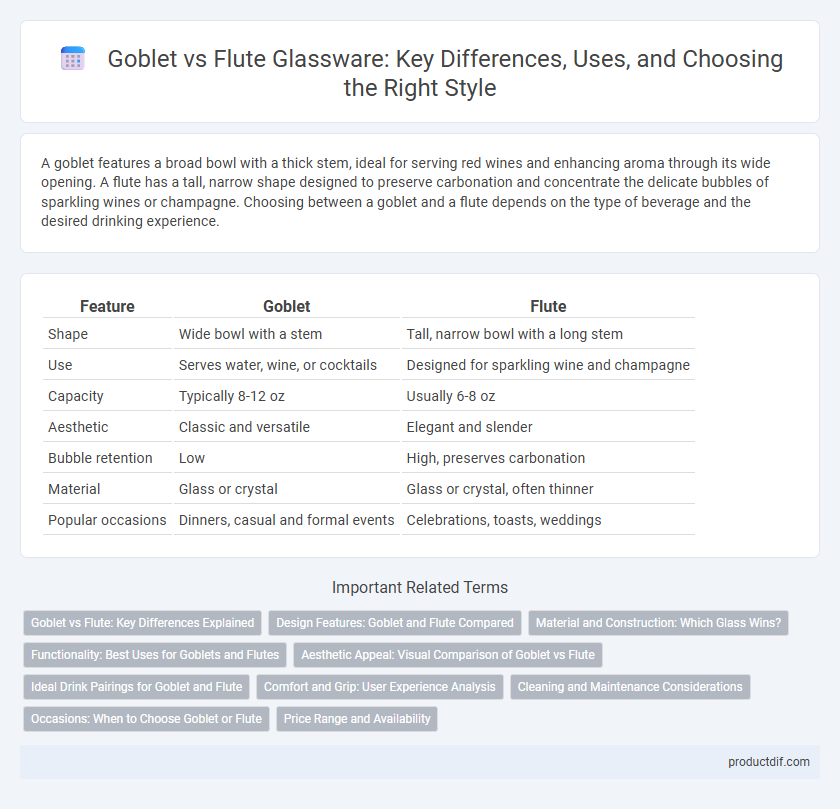A goblet features a broad bowl with a thick stem, ideal for serving red wines and enhancing aroma through its wide opening. A flute has a tall, narrow shape designed to preserve carbonation and concentrate the delicate bubbles of sparkling wines or champagne. Choosing between a goblet and a flute depends on the type of beverage and the desired drinking experience.
Table of Comparison
| Feature | Goblet | Flute |
|---|---|---|
| Shape | Wide bowl with a stem | Tall, narrow bowl with a long stem |
| Use | Serves water, wine, or cocktails | Designed for sparkling wine and champagne |
| Capacity | Typically 8-12 oz | Usually 6-8 oz |
| Aesthetic | Classic and versatile | Elegant and slender |
| Bubble retention | Low | High, preserves carbonation |
| Material | Glass or crystal | Glass or crystal, often thinner |
| Popular occasions | Dinners, casual and formal events | Celebrations, toasts, weddings |
Goblet vs Flute: Key Differences Explained
Goblets feature a wide bowl and thick stem designed for enhancing the aroma and flavor of red wines and water, while flutes have a narrow, elongated shape that preserves carbonation in sparkling wines like champagne. The wider opening of a goblet allows more air exposure, making it ideal for complex beverages, whereas the flute's slender form minimizes surface area to maintain bubbles longer. Choosing between goblet and flute depends on the beverage type and desired sensory experience, with goblets suited for still wines and flutes optimized for effervescent drinks.
Design Features: Goblet and Flute Compared
Goblets feature a wide bowl and sturdy stem, designed to enhance the aromas and flavors of red and white wines by allowing ample air exposure. Flutes have a tall, narrow bowl with a longer stem, specifically crafted to preserve carbonation and showcase the bubbles of sparkling wines and champagnes. The design differences between goblets and flutes directly impact the tasting experience, with goblets promoting aeration and flutes maintaining effervescence.
Material and Construction: Which Glass Wins?
Goblets are typically crafted from thicker, heavier glass or crystal, providing durability and a classic aesthetic ideal for red or white wines. Flutes are made from thinner, more delicate glass designed to preserve carbonation in sparkling wines and champagne, emphasizing elegance and finesse. In terms of material and construction, goblets win for sturdiness and versatility, while flutes excel in enhancing sparkling wine experience.
Functionality: Best Uses for Goblets and Flutes
Goblets are best suited for serving red wines, water, and robust beverages due to their wide bowls that enhance aeration and flavor development. Flutes are designed for sparkling wines and champagne, with their narrow shape preserving carbonation and directing bubbles to the surface. Choosing between goblet and flute depends on the beverage's characteristics and the desired drinking experience.
Aesthetic Appeal: Visual Comparison of Goblet vs Flute
The goblet features a broader bowl and shorter stem, offering a classic, robust silhouette that enhances the visual appeal of red wines by allowing ample light exposure. The flute's tall, slender design with a narrow bowl accentuates the elegance of sparkling wines, showcasing bubbles rising gracefully and adding a refined aesthetic. This contrast in shape not only highlights the beverage's characteristics but also influences the overall table setting ambiance, with goblets imparting a traditional vibe and flutes rendering a modern, sophisticated look.
Ideal Drink Pairings for Goblet and Flute
Goblets excel in serving rich red wines such as Cabernet Sauvignon and Merlot, as their wide bowl enhances aeration and intensifies the wine's complex aromas and flavors. Flutes are ideal for sparkling wines like Champagne and Prosecco, as their narrow shape preserves carbonation and directs bubbles to the surface, enhancing the effervescence and crispness of the drink. Selecting the appropriate glassware optimizes the tasting experience and highlights each beverage's unique characteristics.
Comfort and Grip: User Experience Analysis
Goblets feature a broader bowl and a sturdy stem that provide a comfortable grip and stable handling, reducing the risk of slips during use. Flutes have a slender, elongated shape that may require a more delicate hold, potentially challenging comfort for extended drinking sessions. User experience favors goblets for ease of grip and stability, while flutes excel in elegance but demand careful handling.
Cleaning and Maintenance Considerations
Goblets, with their wider bowl and sturdy stem, often require more thorough cleaning to remove residue from the larger surface area, while flutes, designed with narrow bowls, tend to accumulate fewer deposits but can be challenging to clean inside due to their slim shape. Both types benefit from hand-washing and gentle drying to prevent water spots and maintain clarity, though goblets may tolerate dishwasher use better if space permits. Proper drying and storage techniques, such as using a lint-free cloth and storing upright, help preserve the durability and appearance of both glassware styles.
Occasions: When to Choose Goblet or Flute
Goblets are ideal for casual dinners, wine tastings, and events where versatility and a comfortable grip are important for red or white wines. Flutes are best suited for celebratory occasions such as weddings, New Year's Eve, and champagne toasts, where the narrow bowl preserves carbonation and enhances the visual appeal of sparkling wines. Choosing a goblet enhances the aroma and flavor of still wines, while flutes maintain the effervescence and elegance of sparkling beverages.
Price Range and Availability
Goblets typically range from $15 to $50, offering a wide selection available in most retail and online stores, while flutes usually cost between $10 and $40 with greater availability in specialty glassware shops. The price variance for goblets reflects their diverse designs and materials, whereas flutes often have a more standardized shape leading to more consistent pricing. Both types are readily accessible, but flutes are generally more common for events due to their affordability and availability in bulk.
Goblet vs Flute Infographic

 productdif.com
productdif.com